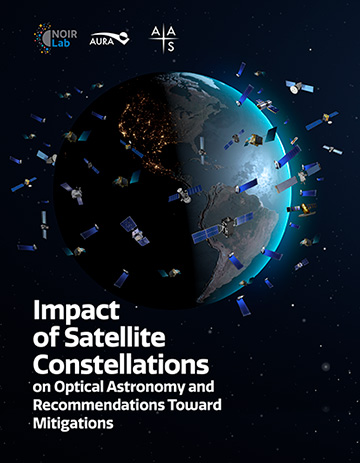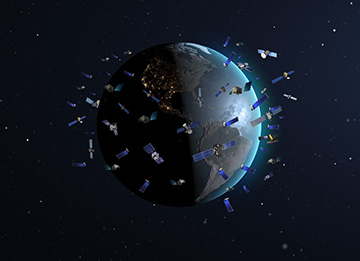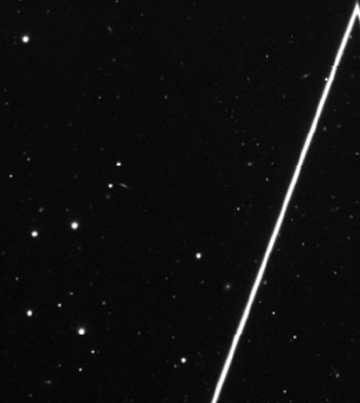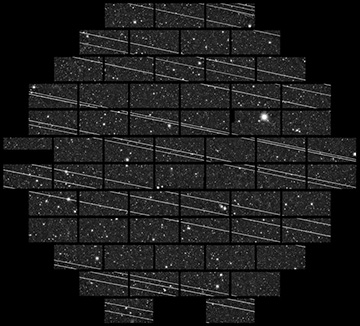
[Image: NOIRLab / NSF / AURA / P. Marenfeld]
In the next decade, if all goes according to plan, a number of new, next-generation ground-based astronomical observatories will come online, with the aim of peering into the deep sky at the faintest objects yet probed. The new telescopes, astronomers hope, will allow groundbreaking findings on dark matter and energy, the first stars in the universe, exoplanets and a wide range of other cosmic mysteries (see “A Deeper View of the Cosmos,” OPN, September 2020).
But amid the celebration of the new science to come, there’s been a ghost at the banquet—plans by SpaceX, Amazon, OneWeb and others to place tens of thousands of communication satellites in low-Earth orbit (LEO). These constellations of LEO satellites, or “LEOsats,” promise to leave trails and flares of light and other artifacts in the long observations taken by ground-based telescopes as they reach ever deeper into the dark sky. And the sheer number of LEOsats planned, by these companies and others, will make their presence in the night sky very difficult to work around.
On 25 August 2020, the U.S. National Science Foundation’s NOIRLab and the American Astronomical Society (AAS) released the report of a workshop, Satellite Constellations 1 (SATCON1), that was held from 29 June to 2 July 2020. The workshop’s goal was to start coming to grips with how to mitigate the effects of these giant new commercial ventures on ground-based astronomy.
The sobering conclusion was that—short of not launching them at all—there really is no way to completely negate the impact of the vast new flocks of LEOsats on optical astronomy. And even partial mitigation will require a huge, coordinated effort involving astronomers, both professional and amateur, and the operators of the satellite fleets.
Starlink et al.
The best known of the new satellite-constellation projects is Starlink, the plan by SpaceX to put thousands of LEOsats into orbit to provide “high-speed broadband internet to locations where access has been unreliable, expensive or completely unavailable.” Each of the 260-kg satellites in the fleet will bristle with technology including phased-array antennas, ion propulsion, navigation sensors and autonomous systems for collision avoidance. The company expects to expand its system to “near global coverage of the populated world” by next year.
Several other large undertakings are eyeing the same market as SpaceX. In July, the online retailer Amazon received approval from the U.S. Federal Communications Commission (FCC) to launch its own megaconstellation of thousands of satellites, Project Kuiper. And a third big player, the British firm OneWeb, in May requested FCC permission to launch as many as 48,000 satellites—though the company’s recent bankruptcy filing may complicate its plans.
107,000 “photobombers”
In November 2019, a wide-field image from the Dark Energy Camera at the Victor M. Blanco 4-meter telescope, Cerro Tololo, was crossed by several Starlink satellites. [Image: CTIO/NOIRLab/NSF/AURA/DECam DELVE Survey] [Enlarge image]
The LEOsats launched by these projects, and others, catch and reflect sunlight as they sail across the night sky, leaving bright streaks in the time exposures captured by telescopes—a phenomenon that has been likened to “photobombing” astronomical images. Their impact is already starting to be felt in observations, with only a relative handful of the satellites in orbit thus far. And, according to the new NSF–AAS report, as many as 107,000 of the LEOsats may go into orbit over the next decade.
The SATCON1 workshop was pulled together to begin fleshing out how to mitigate that vast fleet’s impact on science. The virtual gathering involved more than 250 astronomers, engineers, commercial satellite-fleet operators and other stakeholders, including dark-sky advocates, amateur astronomers and astrophotographers. Among the commercial firms, SpaceX was particularly conspicuous and active in the SATCON1 effort, but representatives of Amazon Kuiper and OneWeb also attended the workshop.
The only true mitigation: Don’t launch
At a press event announcing the SATCON1 findings, Jeff Hall of the Lowell Observatory, who co-chaired the workshop, was at pains to emphasize the “constructive and collaborative” process between the scientific and commercial stakeholders. He singled out SpaceX in particular for setting “an excellent example of a collaborative effort between astronomy and industry to manage this problem.”

[Image: NOIRLab / NSF / AURA / P. Marenfeld]
As the report makes clear, however, to mitigate the impact of the megaconstellations, both the observatories and the satellite operators will have their work cut out for them. “The main takeaway from our findings,” said SATCON1’s other co-chair, Connie Walker from NSF’s NOIRLab, “is that no combination of mitigations will eliminate the impact of satellite constellations on optical astronomy.” The only way to truly do that would be not to launch them at all—but “while this may be an option,” Walker noted drily, “it’s not viable for industry.”
Possible countermeasures
That said, the SATCON1 working groups were able to zero in on a number of other countermeasures—most of them possible only with the cooperation of the satellite operators. One was to keep the satellites at orbits below 600 km, where they are less likely to be visible for long intervals after twilight. The operators could also include steps to darken the satellites, in all orbital phases, into their satellite and mission designs, and orient the satellites in orbit with their edges pointing toward Earth, to minimize reflected sunlight.
Still other mitigations might include better pointing algorithms for the observatories themselves, to allow them to avoid known satellite crossings, and trying to rub satellite streaks out of astronomical images using software. Walker pointed out, however, that these interventions “may not be feasible for many science programs.”
Indelible trails

A LEOsat trail in a portion of a Subaru Telescope CCD image. [Image: R. Wainscoat, University of Hawaii]
Indeed, the community is far away from getting even to these partial mitigations. Richard Green of the University of Arizona’s Steward Observatory, who chaired the metrics working group of SATCON1, noted that the information accuracy required by the observatories to predict and adjust for satellite positions is “at least an order of magnitude” finer than the satellite companies can currently provide. Anthony Tyson of the University of California, Davis, and the Vera Rubin Observatory, separately noted that, to remove “electronic echoes and light-trail artifacts” from the facility’s high-end CCD camera would require the satellites to be at least ten times dimmer than they currently are.
Even with the mitigations, Tyson pointed out, the satellite trails will still exist in some form in the data for the Rubin telescope, and for other projects seeking to probe faint objects in the dark sky. “The satellite trail itself is still there,” he said, and that “vastly complicates data analysis and limits the discoveries … These facilities are actually designed to probe the dark sky to unprecedented faintness for dynamic events. They will require fewer and fewer LEOsats to realize their full potential”—a far cry from the rapidly increasing number of satellites now envisioned.
Ambitious mitigation agenda
Faced with this situation, the SATCON1 report laid out an ambitious agenda for the stakeholders involved. The workshop participants recommended that observatories focus on developing and improving software algorithms, both to erase satellite trails from the data and to predict satellite locations with greater precision.
Satellite operators, the report authors said, should design and deploy the LEOsats to minimize their impact, making them darker and tweaking their position in orbit to minimize the chances that they will gum up the images of ground-based telescopes. And observatories and operators need to cooperate to get a much better idea of the science impact of these megaconstellations, and to improve information about their positions in the sky. For the latter goal, the report suggests building a comprehensive network of professional and amateur astronomers to gather data on satellite orbits that can feed positional modeling.
These steps, the report’s authors believe, could go some distance toward mitigating the “most damaging impacts” of the satellite megaconstellations on scientific astronomy. But even if they all come off without a hitch, it is hard to imagine that the presence of more than 100,000 new satellites, lofted into orbit by a variety of companies and governments—some of which may care little about new insights on black holes or dark energy—won’t severely complicate the already difficult job of extracting discoveries from the deep sky.
A second workshop, SATCON2, which will focus on policy and regulation, is planned for the first half of 2021.

